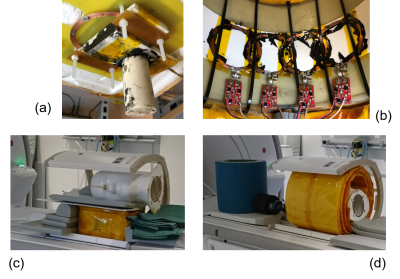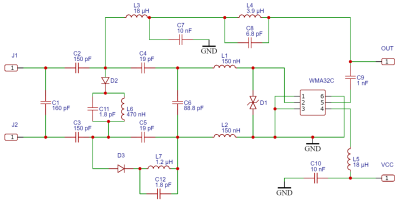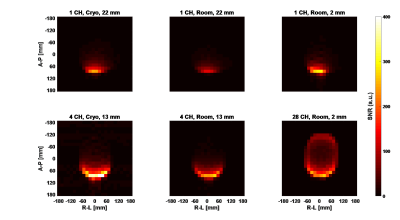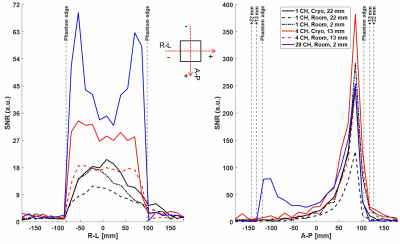2502
Towards a cryogenic RF coil array for 13C human head imaging: first experience1Department of Electrical Engineering, Technical University of Denmark, Kongens Lyngby, Denmark, 2Department of Health Technology, Technical University of Denmark, Kongens Lyngby, Denmark
Synopsis
A cryogenic coil and a dedicated cryostat for 13C human head imaging is developed. A 1.90-fold SNR enhancement over a room temperature coil is observed experimentally. To verify the retention of SNR enhancement in arrays, a 4-channel cryogenic coil array and another cryostat are also developed. The superior performance to a room-temperature array is confirmed experimentally.
Introduction
Cryogenically cooled coils can improve SNR in magnetic resonance imaging (MRI) especially at low frequencies1. However, up to present, use of cryogenic coils for human-sized coils for 13C imaging remains barely explored2. In this work, cryogenic setups for human head MRI of 13C at 3 T (32 MHz) are proposed. First, the performance of a single element is characterized using a cryostat where the coil is cooled to ‑169°C (104 K). Then, a 4-channel array is built and mounted on a full-head cryostat where the coils are cooled to ‑162°C (111 K). A 1.54-fold SNR improvement is observed on MR images of a head phantom.Methods
Two experimental setups are made. Setup 1 is for single coil evaluation and shown in Fig. 1(a), (c). A copper coil of 81.6 mm outer diameter, 69.2 mm inner diameter and 0.64 mm thickness is matched to a preamplifier (WMA32C, WanTCom, Chanhassen, USA) as described by Reykowski et al3. The output impedance of the matching network is 50 Ω. The maximum decoupling is achieved at 32.13 MHz. The circuit schematic is given in Fig. 2. Later, the coil is installed on a self-developed cryostat where the temperature reaches ‑169°C (104 K) after 20 min of cooling. In this cryostat, the coil-to-sample distance is approximately 22 mm. After cooling for 30 min the temperature on the phantom surface is 4.9°C without an external supply of warm air. The Q factors of coils are measured before and after cooling to estimate possible SNR improvement following the approach described by Ginefri et al4.Setup 2 is prepared for a 4-channel coil array experiment, shown in Fig. 1(b), (d). Coils identical to the one described above are overlapped to minimize mutual magnetic coupling. Afterwards, the array is installed on another self-developed cryostat supporting a higher number of elements. The temperature in that cryostat reaches ‑162°C (111 K) within 40 min. After another 30 min, the temperature on the phantom surface is 8.5°C. This cold temperature can be easily compensated by external warming2. The inner and outer surfaces of the cryostat are clad in Aerogel layers for thermal insulation, which gives a coil-to-sample distance of approximately 13 mm.
MR imaging experiments are performed on a human head phantom of ethylene glycol (99.8%, natural abundance 13C) and NaCl (17 g/L). A CSI sequence (24×24 acquired points, TR 1000 ms, FOV 360×360×20 mm3) is used. SNR measurements are conducted for both setups 1 and 2, under both room and cryogenic temperature. For comparison, the same coil in setup 1 is tested when placed 2 mm from the head phantom. A 28-channel array at room temperature built with identical loop coils is used as a reference.
Results
In setup 1, the measured Qs of the coil are Qlr = 225, Qur = 405, Qlc = 286, Quc = 706, where subscripts “l” and “u” denote sample loaded and unloaded cases, “r” and “c” denote room and cryogenic cases, respectively. By calculation, a 1.31-fold SNR gain can be obtained by cooling.The SNR maps obtained are shown in Fig. 3. SNR values along central axes of the phantom are plotted in Fig. 4. The highest SNR values are 247 for 1-channel cryogenic coil, 130 for the room-temperature coil 22 mm from the phantom, 296 for the room-temperature coil 2 mm from the phantom, 417 and 270 for the 4-channel array at cryogenic and room temperature, 265 for the 28-channel array at room temperature. The ratio of cryogenic to room temperature SNRs are 1.90 for the 1-channel coil 22 mm from the phantom and 1.54 for the 4-channel array, respectively. The 4-channel array at cryogenic temperature has a 1.57-fold SNR gain over the 28-channel array at room temperature.
Discussion
The SNR measurement results demonstrate that the cryogenic 1-channel coil has a better performance compared with a room-temperature coil with the same separation of 22 mm. Cryogenic coils can be extended to an array with the SNR improvement largely retained.For the 1-channel coil, the SNR gain is predicted to be 1.31 but turns out to be 1.90. An explanation is that the component values in the matching circuit are selected for cryogenic temperature. At room temperature, the matching circuit is off the optimal noise matching while contributing more noise itself, which decreases the room-temperature SNR by an extra amount.
In addition, Fig. 3 and Fig. 4 indicate that a coil 2 mm from the phantom at room temperature outperforms a coil 22 mm from the phantom at cryogenic temperature. This emphasizes the importance of putting coils as close to objects as possible. The detrimental large distance is caused by suboptimal design of the cryostat in setup 1. This is improved in setup 2, where the coil-to-phantom distance is reduced to 13 mm.
Conclusion
Cryogenic coils can provide significant SNR improvement for 13C human head MRI at 3 T. The superior performance can be largely retained when coils are extended to a 4-channel array. The results open the possibility to develop highly sensitive cryogenic coil arrays for 13C human head MRI.Acknowledgements
No acknowledgement found.References
1. Ginefri JC, Poirier-Quinot M, Girard O, Darrasse L. Technical aspects: Development, manufacture and installation of a cryo-cooled HTS coil system for high-resolution in-vivo imaging of the mouse at 1.5 T. Methods. 2007;43(1):54-67. doi:10.1016/j.ymeth.2007.03.011
2. Sánchez Heredia JD, Baron R, Hansen ESS, Laustsen C, Zhurbenko V, Ardenkjær‐Larsen JH. Autonomous cryogenic RF receive coil for 13 C imaging of rodents at 3 T. Magn Reson Med. 2020;84(1):497-508. doi:10.1002/mrm.28113
3. Reykowski A, Wright SM, Porter JR. Design of Matching Networks for Low Noise Preamplifiers. Magn Reson Med. 1995;33(6):848-852. doi:10.1002/mrm.1910330617
4. Ginefri JC, Darrasse L, Crozat P. High-Temperature superconducting surface coil for in vivo microimaging of the human skin. Magn Reson Med. 2001;45(3):376-382. doi:10.1002/1522-2594(200103)45:3<376::AID-MRM1049>3.0.CO;2-R
Figures



